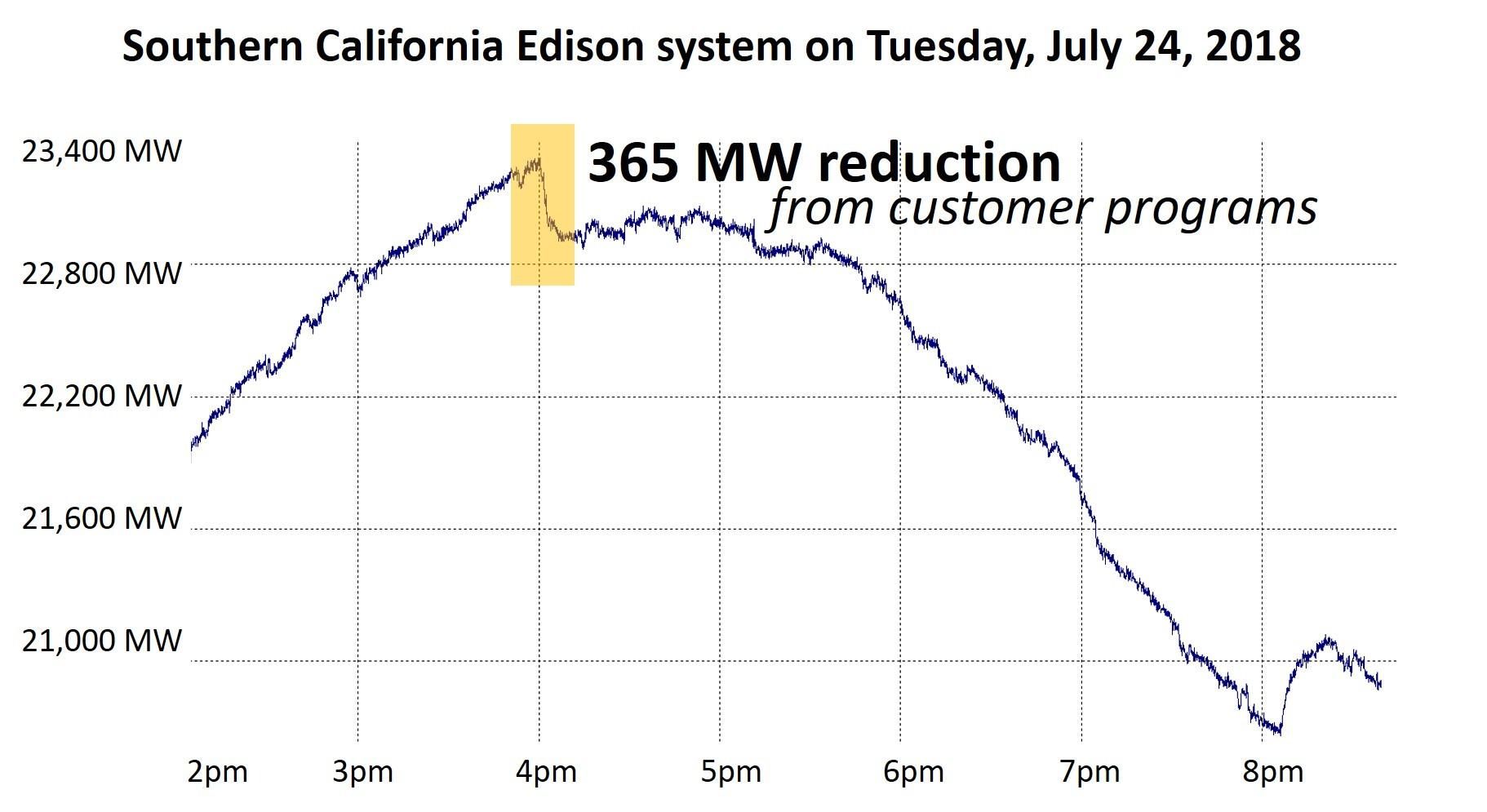It looked like California’s power grid was in for a rough couple of days last week.
On July 23, the California Independent System Operator (CAISO) notified electricity customers that it had issued a statewide Flex Alert, and was calling on residential customers to reduce their energy use from 5 to 9 p.m. on July 24 and July 25, "due to high temperatures across the western U.S., reduced electricity imports, tight natural gas supplies in the Southern California area, and high wildfire risk."
It wasn’t a pretty picture. Temperatures were expected to reach the triple digits, and CAISO’s forecasted system peak appeared to surpass available supply (although CAISO keeps a reserve margin).
For July 25, CAISO’s day-ahead forecast peak was 49,665 megawatts. The system’s available capacity was 45,633 megawatts.*
But luckily for the Golden State grid, a breeze picked up and Californian electricity consumers stepped in.
CAISO Current and Forecasted Demand for July 25, 2018

When a Flex Alert is called, consumers are urged to conserve electricity — especially during the late afternoon and evening when they come home from work and energy use typically spikes — by turning off all unnecessary lights, using major appliances later in the evening and setting air conditioners to 78 degrees or higher.
On July 24, those collective actions reduced consumer demand by 450 megawatts, according to Anne Gonzales, senior public information officer for CAISO.
The Flex Alerts program can play a meaningful role in avoiding power outages, but it is entirely voluntary. For that reason, the response rate on the second day of a Flex Alert is usually lower. “Because it’s hot!” said Gonzales.
But on July 25, energy savings actually went up. According to Gonzales, CAISO reduced demand by 540 megawatts that day. Given that 1 megawatt powers roughly 1,000 homes, the Flex Alert response amounted to enough to power 500,000 homes.**
“Californians really responded well,” said Gonzales. “They understand the concept that if they can sacrifice a little leading into the hot weather that we can prevent having to take more drastic measures, including rotating power outages. So everybody did their part.”
It's a good thing. Even with the additional effort from California electricity consumers, CAISO hit a new peak record for 2018 last Wednesday of 46,424 megawatts. Earlier in the month, ERCOT set a new record for all-time system peak demand in Texas.

While it’s notable that energy consumers conserved 990 megawatts over CAISO’s two-day Flex Alert period, they aren’t the only reason California was able to avoid blackouts.
Temperatures ultimately came in 2-3 degrees below the forecast thanks to an offshore breeze in Southern California. That breeze played a major role in reducing demand, said Gonzales. But utility-run demand response programs were also important.
In Southern California Edison territory, more than 200,000 residential and 9,000 business customers clipped the system peak last week amid the heat wave. SCE called on customers participating in its Summer Discount Plan for several hours on July 23, 24 and 25. During a 4-hour demand response call last Tuesday, SCE saved 365 megawatts from its customer programs.
“For our system, that is a very successful and sizable event and response,” said Jill Anderson, vice president of customer service operations at SCE.
Depending on their program, residential customers saw their air conditioning units remotely turned off or turned down by the utility. In response, they're compensated up to $180 over the season. Participating businesses can receive up to $225 for giving SCE control of their air conditioning unit.
SCE calls up to 20 hours of events per year based on market conditions, said Anderson. There is no scenario where the utility hasn't called on participating customers, she added.
"The system can certainly meet peak demand or even exceed peak demand, but it stresses the equipment and we see greater outages at the higher points of system capacity," Anderson said. "So we’re always looking for [ways] to try to bring the overall load in below the peak."
The fact that some customers have solar, energy storage and energy-efficient technology on site can be a resource to the grid, depending on how it's used, she said. One of the biggest utility pilot projects designed to test distributed energy resources as a grid asset just got the go-ahead from California regulators.
It's important that we continue to use all of these different strategies, because we don’t want to have to keep building the grid for these peak days, every time we have a heat wave," said Anderson. "We want to maximize the utilization of the assets we already have installed."
As for the utility's more traditional demand response programs, right now there are no plans to call another event, she said. But the summer forecast continues to be hot and sunny, with more extreme heat waves and wildfires expected in the future.
*A previous version of this story stated that California's grid faced a blackout. This story was corrected to reflect that CAISO never faced a blackout, also known as an unplanned loss of transmission. Ultimately, the grid operator also avoided brownouts, also known as a rotating power outage.
**The reduction of 540 megawatts in the Flex Alert was enough to power more than half a million homes. A previous version of this story incorrectly stated that more than half a million customers are believed to have participated in CAISO's Flex Alert.




